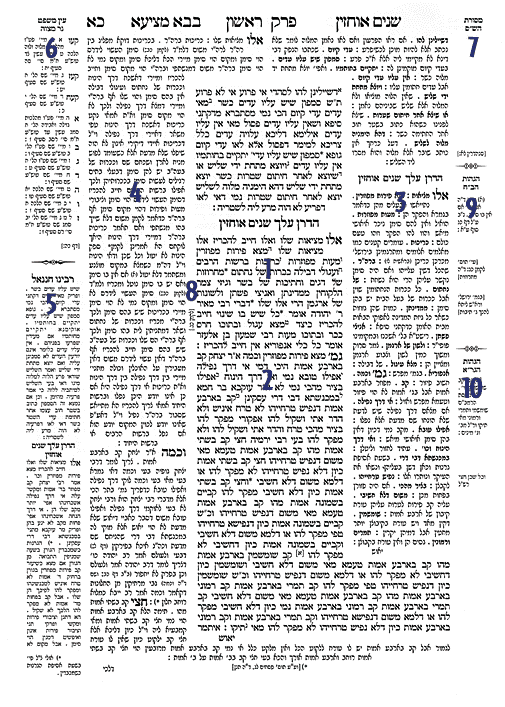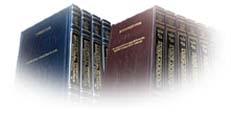

|
1. Mishna is the first major transcription of the oral torah.
forseeing a dispersion of the Jewish people
throughout the world, Rabbi Y'hudah haNossi (Judah The Prince)put the Mishna into written form around the year 200 C.E. (A.D).
2. Gemora is a written record of analytical discussions of the Mishna, along with philosophy, ethics, and practical advice, by the rabbinic authorities who lived between 200 and 500. This is the main body of the Talmud, consisting of some 4,500 pages of text. 3. This area is Rashi script, it is always on the inner column near the spine, think of it as a type of Hebrew italics to differeciate between sections on the daf. Rashi is an acronym for Rabbi Shlomo Isaac, an 11th-century French commentator. Rashi explains the difficult terms and helps students understand the Gemara's analysis and reasoning. Rashi interestinglly adds some French words in his notes. French linguists sometimes look at Rashi's notes to find lost French words when composing Modern dictionaries. 4. Tosefos, which literally means "additions," are collections of comments, generally based on Rashi, made by French and German rabbis between 1100 and 1300. These comments discuss conceptual issues raised in the Gemora, and contrast these with concepts raised in other Gemora texts. 5. Hananel are comments by a 16th-century North African Talmudist. 6. Eye of Justice, Mitzvo Candle, by 16th-century Italian scholar Rabbi Joshua Boaz, includes notes referencing final legal decisions found in Maimonides's and others' codes of Jewish law. 7. Talmud Cross-References 8. Light of the Bible includes references to Biblical quotations. 9. Bach's Annotations, textual emendations by 17th-century Polish scholar Rabbi Joel Sirkes, note variant texts that appear in early editions of the Talmud. 10. Gra's Annotations, concise notes by 18th-century Lithuanian scholar The Vilna Gaon, suggest fascinating insights into legal rulings. Similar annotations by the Lubavitcher Rebbe and other 19th- and 20th-century scholars are planned for the new edition of the Talmud. |
Rabbosai, thank you for dropping by this section of the webpage~
The word 'talmud' literally means 'study'. The Talmud is sometimes
referred to as SHaS. Shas is a shortened form of the term 'Shisha Sedarim (six orders), a reference to the six orders of the Mishna. Daf Yomi is a cycle in which you study a Daf (page) a day of Talmud. Shas takes 7 years to complete. For more on the current date daf, click HERE

 by Artscroll, however if you like the advantages of computer searches and want something along with your seforim, Davka has the entire Talmud on one cd rom.
by Artscroll, however if you like the advantages of computer searches and want something along with your seforim, Davka has the entire Talmud on one cd rom.